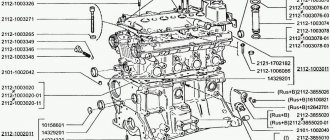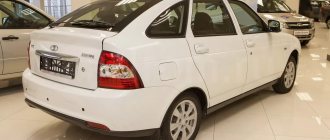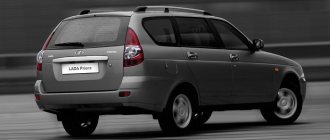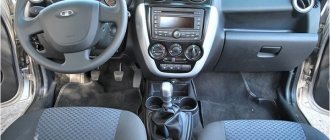History of creation
The VAZ 2112 hatchback model was produced since 1999, becoming the successor to the 2110 sedan and 2111 station wagon. The “Twelfth” became a close analogue of the famous tenth model, but had a slightly shortened body. As planned by the manufacturers, the 2112 was supposed to combine all the advantages of the “ten” and “eleven”, so the five-door hatchback was chosen as the body type.
VAZ-2112 Pre-production (1994)
The 12th model began to be mass produced in 2000; it lasted 8 years on the assembly line. Unlike the sedan and station wagon of the tenth series, the assembly of the “dvenashka” was not transferred to the Ukrainian ones.
Although the twelfth model was positioned as an improved “ten”, the improvements here are very conditional and not always obvious. Therefore, the difference between these two models is not too big. AvtoVAZ designers continued to look for new solutions, as a result of which other lines and modifications appeared, which also have both their pros and cons.
Story
The production of this model began 4 years after the launch of the VAZ 2110 sedan, that is, in 1999. The car sold quite successfully, and in 2006 a small restyling was carried out, the changes affected only the interior, and then the steering wheel was replaced and a dashboard from Lada Priora was installed.
In 2008, production was curtailed due to the same Priora, but this model, unlike the VAZ 2110 and VAZ 2111, did not go into production at the Bogdan auto company in Ukraine.
The model is a car that handles better than the sedan, the body is to blame here, it allowed the car to become more rigid and take corners better. The coupe version has an even more brutal body at the rear, and some corner enthusiasts install a strut on the A-pillars, resulting in the car becoming even better to drive.
Exterior
Looking at the “twelve”, it immediately becomes clear that its prototype was the “ten”. Externally, these two cars are very similar, it is immediately clear that they belong to the same family: the same rounded, smooth lines and roundness of the body, the same heaviness, especially in the rear of the car. Of course, whether you like the design of the car is a matter of taste. Many note that the twelfth model is the most beautiful of the entire line.
Lada 2112 (1999–2008)
It is also noticeable that the designers tried to give the car some sportiness by adding a rather large spoiler to the trunk door, rounding the body as much as possible and replacing the thirteen-inch “tens” wheels with 14 inches. However, despite all the developers’ tricks, it’s quite difficult to call the 12th Lada sports. Changes also affected the roof of the car. Here it is more sloping, making the car look more interesting. The body length of the 2112 model is slightly shorter than that of the “ten”.
If we compare the car with the 11th model, then the rear door is noticeably larger, which can be opened both from the outside using the key and from inside the cabin by pressing the corresponding button. But the fifth door opens only if you pull it on the plastic spoiler, which does not have a positive effect on it.
Lada 2112 (1999–2008)
The trunk, like the hood, boasts gas struts. It is convenient to load, the volume is 400 liters. The shelf in the trunk rattles and knocks a lot when driving. You can get into the car through the trunk door if all other doors are blocked or jammed.
Interior
The interior of the car is simple and not very presentable. You won’t find any “bourgeois excesses” here. The only exception is electric windows and heated front seats, but this is not found in all modifications of the car.
The steering wheel is large and very antediluvian. The steering column is height adjustable only. Moreover, some models come without power steering and electric power steering, which is a significant disadvantage.
Torpedo Lada 2112 (2006-08)
To the right of the steering wheel is a console with a heater, radio, on-board computer (if equipped) and main keys. The heater, in theory, should be adjustable in order to separately heat the windows, top and bottom of the cabin, but in reality everything is heated at once. There are no airbags in the cabin.
The glove compartment is quite large and even has a backlight. The position of the exterior mirrors is adjusted by a special lever, but it is adjusted very mediocrely, so usually no one uses it.
A tall person is unlikely to be comfortable in the back row of seats, because his head will touch the ceiling. Long-legged people will also not be very comfortable, since there is quite a bit of space left to the front seats. The width of the cabin is cramped; only two passengers can be comfortably accommodated. Three people will fit, but they will be cramped.
Interior of Lada 2112 (1999–2008)
The rear windows are manual and constantly stick. As anyone who has ever owned a Lada, Zhiguli or any other AvtoVAZ product knows, the windows go down exactly to the level they want. Often it is completely impossible to lower the glass completely; it gets stuck in the middle and does not move anymore.
The rear row seats recline together or separately, which increases the size of the trunk, so you can put a fairly large load in the car.
How to check the overall and geometric dimensions of the VAZ 2110 body visually or instrumentally?
Cars coming off the assembly line have strictly verified body dimensions.
As a rule, no one pays much attention to this when buying a new car. However, the need to measure and check the geometric dimensions of the VAZ 2110 body with the instruction manual may arise in the following cases:
- you buy a car second-hand and are not sure that it has not been in an accident. It is because of this that, as a rule, the geometry of the VAZ 2110 is most often violated;
- you yourself got into an accident, even ran into a stone, curb, etc., causing the car to receive a serious blow.
Basic reference dimensions of attachment points for components and assemblies
The geometry of the VAZ 2110 body is described in the operating instructions. The main parameters for checking body geometry are as follows:
- There should be 4.265 meters between the extreme points of the front bumper and the rear bumper.
- The distance between the center of the front wheel and the center of the corresponding rear wheel is 2.492 meters.
- The distance from the center of the front wheel to the end point of the front bumper is 0.829 meters.
- The distance from the center of the rear wheel to the end point of the rear bumper should be 0.944 meters.
The height of the car is always stationary - 1420 mm
You should try to avoid welding and other work that involves thermal heating of the metal.
Engine modifications
Under the hood of Lada 2112 (1999–2008)
In total, there are 6 engine modifications for the VAZ 2112:
- 21120 – the basic version of the 1.5 liter internal combustion engine. The disadvantage is the presence of free space inside the cylinder head and the block itself.
- 21124 – increased power (up to 89 hp) and increased engine capacity (up to 1.6 liters).
- 21126 – power increased to 98 hp. with an engine capacity of 1.6 liters.
- 21127 – the volume is still 1.6 liters, but the power is increased to 106 hp.
- 21128 – power is 105 horses, which is achieved by increasing the volume of the combustion chamber (1.8 liters). The problem with the valves bending has been resolved.
- 21129 – the engine has a volume of 1.8 liters, a phase shifter has been added.
Options
Lada 112 Coupe (2002–06)
The car was produced in several versions:
- 21120 – basic version with a 16-valve 1.5-liter engine with multipoint injection. Equipped with 14-inch wheels. Engine power – 93 hp.
- 2112i – version with fuel injection system.
- 21120 GLI (Gran Luxury Injector) – luxury version of the car.
- 21121 – modification with an engine capacity of 1.6 liters. Power – 81 hp
- 21122 – simplified, budget option. It was produced without electric windows, with 13-inch wheels and brakes from the VAZ 2108.
- 21123 Coupe - a three-door version, the so-called “coupe”, although in fact it is an ordinary three-door hatchback. It was assembled individually and in limited edition. The coupe's body is more rigid, as is the suspension. Handling is better than the standard version. The car was expensive, produced in 2002-2006.
- 21124 – injection version with a 1.6-liter engine. By increasing the depth of the groove in the piston crown, the creators managed to solve the problem of valve bending, which plagues the standard version.
- 21128 – modification with a 1.8-liter engine. Power – 105 hp.
- 2112-37 – racing version with a 1.5 liter engine, equipped with a roll cage.
- 2112-90 “Tarzan” – version with all-wheel drive. A Niva engine (1.7 and 1.8 liters) was installed.
VAZ-2111
The previous modification of a similar body design – the legendary 2104 (“four”) – was already 15 years old by the time the production of 2111 began. VAZ-2111 is the first VAZ station wagon with front-wheel drive.
The trunk volume with a total vehicle load capacity of 500 kg varies from 490 to 1420 liters. This is due to the fact that the rear seats can be folded in such a way as to create a flat horizontal floor, and the backrest, if necessary, can easily be folded out in a ratio of 1:2. If there is a luggage structure, an additional 50 kg of cargo can be placed on the roof. Also, with a towbar, it is possible to tow a trailer up to 1000 kg, equipped with brakes. The car body is mounted on a supporting frame with rubber-metal elements, on which it rests at 10 points. Thanks to this solution, it was possible to reduce the level of vibration and noise in the cabin, and the body became stronger and more durable. The choice of engines for the 2111 is similar to the sedan. There is also a 21110 with an eight-valve 1500 cc engine. cm with a power of 76 l. With.; 21111 with a carburetor engine (from a VAZ-21083) with a volume of 1500 cubic meters. see and 21113 with a sixteen-valve engine with a capacity of 1600 cc. cm increased power.
There were also 3 configuration options - “standard”, “luxury” and “norm”. In 1997, together with the AVTOVAZ Research and Development Center, the DECON design group created a new comfortable SUV and called it “Tarzan”. The car is a hybrid of the body structure and frame chassis of the front-wheel drive models of the “tenth” family with transmission elements and main suspension components from the Niva (2121). Moreover, all units, except for the elongated cardan shafts and the frame itself, are serial.
Specifications
Visibility
Visibility in the cabin is good, everything is perfectly visible from the driver's seat, the glass area is large. However, the rear view is partially blocked by the spoiler.
Body
The bodies of all Lada cars leave much to be desired. They are made of thin and very low quality metal that rusts instantly. The sills, arches and lower parts of doors are most susceptible to corrosion. If you find a VAZ 2112 in good condition, then both the arches and the sills will probably be overcooked.
Mileage
If you monitor the car and the condition of the engine, then the VAZ 2112 can “run” up to 200-250 thousand, which is not too much. On the other hand, the engine can be rebuilt or a new one installed, because Lada engines are obscenely cheap.
Lada 2112 (1999–2008)
The fuel consumption of the “twelfth” cannot but rejoice. So in urban conditions it consumes 7-9 liters per 100 km. On the highway - 5-6 liters.
Transmission
The 12th model was equipped with a 5-speed manual transmission. It differs from the gearbox on the VAZ 2110 only in name.
Disadvantages of a gearbox on a “two-wheeler”:
- unreliability;
- unclear switching;
- strong howl;
- frequent wear of the synchronizer, accompanied by crackling and noise when changing gears;
- oil leaks through seals, breather and gaskets;
- knockout of the gear or refusal to engage due to wear of the bushings;
- failure of bearings and gears after 100 thousand mileage.
Suspension
The front suspension of the VAZ 2112 is independent, the rear suspension is dependent. The problem with all LADA cars is CV joints and bearings that quickly fail. The struts also quickly begin to leak, the springs rust. The quality of spare parts generally leaves much to be desired, including new ones. Owners complain that some elements have to be replaced several times, because new parts arrive already defective or break in the first months of operation.
Pros and cons of the twelfth model
The duality of the design concept led to the fact that the Lada 12 was never the only five-door hatchback in the production program of the Tolyatti plant. The AvtoVAZ hatchback VAZ 2112 rolled off the assembly line from 1999 to 2008. It shared its place on the assembly line with other five-door cars in the same body:
- from 1999 to 2001, Lada 12 and VAZ 2109 were produced in parallel;
- from 2001 to 2004, VAZ 2112, VAZ 2109 and VAZ 2114 were released simultaneously;
- from 2004 to 2008, model 12 was produced in parallel with the VAZ 2114.
The features of the target audience of the 12th fret are very poorly read, in contrast to alternative models. Buyers of the VAZ 2109 represented a large army of staunch supporters of the most popular domestic car of the 90s - the “nine”, glorified in songs. The fourteenth model that appeared later also had many fans. A light face lift only benefited the car. New headlights and the design of the front end refreshed the appearance of the car; it became noticeably more modern, which the market liked.
The Lada 12 had little to offer in this competitive competition. The electronic fuel injection engine control system offered few advantages because the first twelfth models entered the market with a carburetor version of the engine. When injection versions of the Lada 12 appeared, competitors were not slow to repeat this move. All that remained was a more than dubious attempt to follow the ideas of biodesign that was fashionable at that time. Such tuning of the VAZ 112 did not give serious success, because:
- the ideas themselves were 15 years out of date by the time the car appeared;
- they were implemented very clumsily.
In terms of technical parameters, models 2112 and 2114 are very similar. VAZ 2112 is 4 centimeters longer than its brother in the production line. For comparing cars of the same layout, the volume of a cube is great, into which you can fit a car with specific dimensions. This parameter is in the case of model 2114 4122 mm x 1650 mm x 1402 mm = 3817 cubic meters. dm. And for 2112 - 4170 mm x 1680 mm x 1435 mm = 4050 cubic meters. dm. The difference is 5.7%. In terms of total weight, the cars (1410 and 1495 kg, respectively) differ by 5.6%.
But the trunk of the VAZ 2114 is significantly smaller - 330 liters versus 399. Additionally, in Lada 12 you can free up another 330 liters for luggage by folding the rear seats. You can fold them partially - the back is divided in a ratio of 1:2, and the parts fold independently of each other. Car owners note that the interior of the twelfth model is cramped for passengers taller than 180 cm. Common to both cars, car enthusiasts note shortcomings in the operation of the heating system, shortcomings in seat adjustments, as well as a creaky interior.
Chassis and its advantages
On the move, the “two-piece” is akin to a foreign car of those times: soft, smoothly overcoming bumps. The whole feeling is spoiled by the front panel bouncing on the pits.
The clearance of the VAZ-2112 is high even by today's standards. 160 cm along with short overhangs allow you to easily climb curbs and easily drive through large holes without touching the bottom. When fully loaded, due to the design, the rear wheels begin to “shuffle” against the arches.
Disadvantages of VAZ-2112
Most used Twelves are sold with corrosion. It covers the rear fenders, the spare wheel well, the sills, the bottom, and the contour of the windshield rubber seal. If the car has not been looked after, there may be corrosion at the bottom of the doors.
Replacement will cost a decent amount: doors excluding painting - about 9,000 rubles apiece, rear fenders - about 6,000 rubles, a niche for a spare wheel - 1,500 rubles. For painting one element you will have to pay at least 5,000 rubles per element. Even at the slightest hint of rust, run away from the car. It’s better to take a closer look at the well-painted version: it has no corrosion - you won’t have to spend money on repairs.
When buying a 16-valve engine, set aside 6,000 rubles to replace hydraulic compensators (they last no more than 100 thousand km, and if the oil quality is poor, even less), on many cars they knock. The mass air flow sensor often fails. The first signs by which you will know about a breakdown will be increased fuel consumption and high idle speed (replacement - from three thousand rubles).
Also pay attention to the front struts and their supports. The first ones often fail by 30 thousand
kilometers, the tires of the latter begin to peel off (all together will cost from 6,000 rubles).
Another common problem with the VAZ-2112 is non-working rear lights. You will have to either change the board or clean and tighten the contacts. By the way, the rear lights of the “twelve” often fog up, and this, unfortunately, cannot be cured.
Brake system
Front brakes are disc, rear brakes are drum. Although the brakes on the “two-wheeler” are quite mediocre and ineffective, owners most often do not complain about them, because repairs cost a small amount. The brake pedal is usually a little stiff, but the braking distance is acceptable.
Lada 2112 (1999–2008)
We will enter the remaining technical characteristics into the table.
| Parameter | Index |
| Body shape | hatchback (5 doors), coupe (3 doors) |
| Engine volume, l | 1.5, 1.6, 1.8 |
| Length, mm | 4170 |
| Width, mm | 1680 |
| Height, mm | 1420 |
| Wheelbase, mm | 2492 |
| Ground clearance, mm | 160 |
| type of drive | front |
| Gearbox type | 5-speed manual |
| Weight, kg | 1495 |
| Trunk volume, l | 400 |
| Fuel tank volume, l | 43 |
| Fuel type | petrol |
Getting to know the “twelve”
ATTENTION! A completely simple way to reduce fuel consumption has been found! Don't believe me? An auto mechanic with 15 years of experience also didn’t believe it until he tried it. And now he saves 35,000 rubles a year on gasoline!
The VAZ 2112 or “two-piece” car was produced, like its analogues, at the Volzhsky Automobile Plant. It is a 5-door hatchback body, reminiscent of the VAZ 2110 sedan in shape.
Production of the “twelve” began in the 99th year of the last century. The car body was copied from the VAZ 2110, but shortened to 4170 mm. The volume of the luggage compartment is 400 liters. Due to the shortening of the body, the car, compared to the “ten”, began to respond better to turning the steering wheel.
And in general, the model has a sportier character than the VAZ 2110. Combining all the advantages of the “ten”, the VAZ 2112 is also equipped with the rear seat of the 2111 station wagon.
The clear improvements over previous models are as follows:
- Despite the small length of the body, you can increase the small volume of the hatchback by transforming the rear seat;
- Better handling, especially when entering corners.
Like most VAZ models, the “dvenashka” was produced in several modifications and designs. In particular, we note the VAZ 21123 in the coupe body type. This modification even went through 3 body restylings and initially had a unique, original hood and bumper. Subsequently, the model was equipped with a grille and a standard hood.
Body features and the importance of geometric dimensions
In general, the “dvenashka” model is almost the most popular car in the domestic automobile industry, it is cheap and has a good design and a wide variety of body styles.
When developing this model, the manufacturer took into account many factors, including compliance with the individual tastes of each customer. In this regard, several body versions of the VAZ 2112 were produced, each of which had different targets.
Coupe, station wagon, sedan, hatchback - the “two-piece” was equipped with all these body types. The coupe is more correctly called a 3-door hatchback. This is the most rarely seen modification of the VAZ 2112. Its sporty design distinguishes it from other versions of the family, which are generally made quite monotonously.
Body repair VAZ 2112 coupeBody repair VAZ 2112 coupe
Experts believe that the VAZ 2112 coupe has the right to be called the best in terms of body design features and design. In total, about 10 thousand cars of this type were produced, after which production was discontinued.
Dimensions and dimensions also, along with the type of body structure, play a big role in convenience for passengers and good handling. Some modifications of the VAZ 2112 were even equipped with a sunroof, which increases the ease of use of the car.
So, here are the body dimensions of the VAZ 2112:
- Body – hatchback;
- Length, mm – 4170;
- Height, mm – 1435;
- Width without rear view mirrors, mm – 1680;
- Width with rear view mirrors, mm – 1875.
They, as we see from the table, better meet modern requirements and help the machine cope with a greater number of functions. The good spaciousness of the interior and trunk of the “two-wheeler” is a clear confirmation of this. Passengers feel very comfortable inside; the car can carry a lot of cargo if you are planning a long-distance family trip.
Controllability
It would seem that the reduced base (when compared with the “ten”) should have made the car more obedient, but for some reason everything is different with the “two”. Handling here is very mediocre. When turning, you often have to fight with the steering wheel, which constantly strives to return to its original position. There are cars without power steering, the driving of which gives little pleasure, and the steering wheel seems to be filled with lead and generally refuses to rotate adequately.
Lada 2112 (1999–2008)
When cornering, the body often begins to sway and roll to the side, causing the wheels to lose traction on the asphalt. This happens especially often on rough roads. It is better not to accelerate too much in the VAZ 2112, because at high speeds you can easily lose control.
Competitors
Fiat Albea
Fiat Albea (2002–05)
The Fiat Albea is a reliable four-door sedan, very cheap and unpretentious. On the secondary market you can find versions with an engine capacity of 1.4 and 1.6 liters. Albea's body is galvanized, so there are cars with whole metal. This option is perfect for city driving. If you are considering buying a VAZ 2112 specifically for city driving, then the Fiat Albea will be an excellent replacement. Comfort, like any foreign car, will be higher than that of the Lada, there is air conditioning. The build quality is also higher, the sound insulation is satisfactory.
LADA 2114
Lada Samara 2114 (2001–13)
VAZ 2114 is the older sister of the “twelfth”, which is also not intended for high-speed driving and has very mediocre handling. This is a great option for fishing trips. The car, due to its lighter weight, drives perfectly through the fields, it can be rocked and pulled out of any large puddle or hole.
The “fourteenth” does not have a hydraulic booster, but the steering wheel nevertheless rotates well. The 14 is lighter, making it easier to ride off-road, but the lighter weight means less stability on the trail. In strong winds and on sharp turns, the car easily lifts off the ground.
This car, like the 12th model, is suitable for beginners and young people who do not have money for a more expensive and high-quality car.
ZAZ Chance
ZAZ Chance Hatchback (2009–14)
This is another representative of the ultra-budget segment. Like all other domestically produced machines, it is characterized by low quality and low cost. Its interior is a little more comfortable and visually pleasing than that of the VAZ.
Advantages and disadvantages
The main advantage of the Lada, as mentioned earlier, is its low cost. Spare parts can be found everywhere. Even in small towns there are car services with domestic spare parts. Repairs are very cheap.
The remaining pros and cons of the VAZ 2112 are listed in the table for convenience.
| pros | Minuses |
| Cheapness and availability of spare parts | Rapidly rotting body metal |
| Large trunk, expanding due to the rear seats | Low ceilings in the cabin, which is inconvenient for tall people, the cabin is cramped |
| Maneuverability in urban environments | Poor handling |
| Low gasoline consumption, economical | Low quality plastic |
| Powerful stove | Lack of vibration and noise insulation in the cabin |
| Good forward visibility | Low quality of elements and spare parts, frequent breakdowns |
| Nice glass headlights | No airbags |
| Low road tax | No air conditioning |
| Passability on broken and rural roads | Rear view suffers due to protruding spoiler |
| Nice appearance | No power steering |
| Possibility of tuning and restyling | Valve bending when timing belt breaks |
Reviews from VAZ 2112 owners
I bought the car in 2009 with a mileage of 86 thousand kilometers. I immediately changed the brake pads, fluids, and filled the engine with oil. Afterwards I had to change the front struts, bearings, ball joints and steering ends. I haven’t repaired the engine, it doesn’t eat my oil, I’ve added about half a liter over the course of a year. I also changed the front brake discs and pads. Among the advantages, I can mention the engine, a pleasant interior, a spacious trunk, good acoustics and a radio. The car drives smoothly, the gears shift clearly, the braking system is adequate, the steering is sensitive (I have power steering).
Andrey, Samara
I drove a car for a year and can refute all the stereotypes about the domestic automobile industry. Gasoline consumption on the highway is 5 liters, in the city - 7-8! Where else will you find this? Over 20 thousand mileage, only the ignition and consumables were changed: timing belt, spark plugs, gaskets, pipes, etc. Sometimes something leaks, but this is a LADA. We are thinking of selling because we want a newer and more comfortable car, but it’s a shame. Cons: there is no sound insulation at all, but my husband and I taped the trunk and all the doors, it became much quieter. My husband is too lazy to glue the panel. If you're wondering whether it's worth taking, then go for it. As a first car, it’s simply super, especially for young people.
Ekaterina, St. Petersburg
VAZ 2112 is an inexpensive and marketable car with good cross-country ability. I took it to go to work, to the dacha, fishing and to the forest to pick mushrooms. It’s absolutely not a pity to break it on our roads. Naturally, there is no suspension, the CV joints are all crunchy, it all needs to be sorted out. The turning radius is large, visibility is also not very good, especially from the rear. Factory wheels bend a lot, although they straighten out easily. The biggest disease is valve bending if the timing belt breaks. Another disadvantage: everything in the cabin creaks and rattles, the rear shelf from the subwoofer shakes and makes terrible sounds. But for this amount of money the car is excellent. No show-offs or bells and whistles, but cheap to maintain and quite unpretentious.
Evgeniy, t. Tver
As for me, if you choose from the Lada model range, then its appearance is the most beautiful. The interior is comfortable, I have a European panel, seats with lateral support. The dynamics are normal. I had power steering included, which is generally nice for a VAZ. The ride is good, the suspension is just right for driving on our rough roads. Naturally, after a foreign car you feel that the handling is not very good, but overall it’s normal. The reviews write that the struts on the VAZ 2112 quickly die, but everything is fine for me, I drove for 45 thousand and didn’t change anything at all, then I sold it. The build quality is, of course, terrible. And something is constantly leaking, either from the box or antifreeze. It’s better to buy a cheap two-wheeler with cheap spare parts than a junked foreign car.
Sergey, Pskov
I can say that for 100 thousand I definitely wouldn’t have bought a better car. “Classics” don’t appeal to me at all. The cross-country ability of the VAZ 2112 was surprising. I drove it to the dacha on broken roads and to pick mushrooms. She coped better than many foreign passenger cars. Maintainability is also excellent. I easily changed everything myself, spending pennies. Spare parts are much cheaper than for foreign cars. The stove heats well, the cabin is warm in winter, but it warms the legs slowly. The rear seats recline comfortably. I carried boxes of tomatoes, potatoes, pumpkins, and a bunch of bags. Of course, there are also disadvantages. Sound insulation is terrible. I glued the doors, it got better, but the noise still remained. Everything shakes and rattles, the plastic is disgusting. The torpedo makes a lot of noise, especially on dirt roads. Handling on the highway is poor. It’s fine in the city, but on the highway it’s really scary to accelerate above a hundred, it’s very unsafe. The low beam headlights are weak.
Anastasia, Minsk
How much does the VAZ weigh?
Perhaps one of the most popular cars in the post-Soviet space was, is and remains the VAZ. This car has captivated many generations. However, how did it all begin? When was the first VAZ car produced and how much did it weigh? You will learn the answers to these and other questions from this article.
The first VAZ car was produced by the Volzhsky Automobile Plant on April 19, 1970. The make of this car was VAZ-2101 Zhiguli. Its production was carried out according to the analogue of the Fiat concern. Moreover, VAZ owes its appearance to this particular brand of Fiat 124, produced in 1966. Here, in fact, is it:
As a result of some design improvements, the first domestic car, the VAZ 2101 of 1970, was produced:
The weight of this car was 955 kg. Moreover, of this mass the engine weighed 114 kg.
It has not lost its popularity to this day. In 2000, it was recognized as the best car among eighty thousand car enthusiasts surveyed in the CIS countries and Russia. It was named the best car of the century, VAZ 2101. At the time of its production, it was considered the most comfortable, reliable and modern domestic car. Its presence was a sign of wealth and prosperity!
But the Volzhsky Automobile Plant did not stop there. He created entire collections of this car. Each of them differed in its configuration, as well as its total weight. Therefore, now we will compare some VAZ models by their weight.
- VAZ 2102 has a weight of 1010 kg .
- VAZ 2103 has a weight of 965 kg .
- VAZ 2104 has a weight of 1020 kg .
- VAZ 2105 has a weight of 1060 kg .
- VAZ 2106 has a weight of 1045 kg .
- VAZ 2107 weighs 1049 kg .
- VAZ 2108 weighs 945 kg .
- VAZ 2109 weighs 915 kg .
- VAZ 2110 has a weight of 1020 kg .
- VAZ 2111 has a weight of 1055 kg .
- VAZ 2112 has a weight of 1060 kg .
- VAZ 2113 weighs 975 kg .
- VAZ 2114 weighs 985 kg .
- VAZ 2115 has a weight of 1000 kg .
- VAZ 2116 weighs 1276 kg .
- VAZ 2117 has a weight of 1110 kg .
- VAZ 2118 has a weight of 1110 kg .
- VAZ 2119 has a weight of 1110 kg .
- VAZ 2120 has a weight of 1110 kg .
- VAZ 2121 has a weight of 1550 kg .
- VAZ 2122 has a weight of 1122 kg .
- VAZ 2123 has a weight of 1300 kg .
But this is the total weight of a VAZ car. As for some parts of the car, the weight of, for example, a VAZ 2106 can be decomposed as follows:
- The weight of the engine with equipment is 140 kilograms .
- The weight of the gearbox is 26 kilograms .
- The weight of the square shaft is 10 kilograms .
- The weight of the rear axle is 52 kilograms .
- Radiator weight – 7 kilograms .
- Body weight – 280 kilograms .
It will be useful: Do-it-yourself trunk lighting for a VAZ 2114: how to do it, video instructions
On average, the weight of all components of a VAZ car has approximately the same mass. Throughout the entire period of existence of this car, quite interesting facts have been recorded that simply cannot be ignored. It’s hard to imagine that a car weighing an average of 1 ton is very popular.
So, the VAZ 2121 Niva car is not only the most popular throughout the USSR, but also the most exported. Just imagine, this model was produced in 1.8 million cars. And of this amount, 500,000 were sold to more than 100 countries. As we remember, the weight of the VAZ 2121 is 1550 kilograms . This means that over the entire period, 775,000,000 kilograms of this car were sold! Also, this particular model of all Soviet cars was driven in Japan. As for the design of the VAZ 2108, it was developed by the currently well-known company Porshe. Its engine weighs 127.3 kilograms . This became necessary due to the fact that the demand for this brand of car was greatly reduced. For this reason, they decided to modernize it.
Moreover, the VAZ car became more popular because the Lada car was the first car of the famous Formula 1 racer - Kimi Raikkonen. His father loved this car extremely much for its reliability.
So, we learned that each VAZ car model has its own separate weight. But throughout the history of its existence and production, it has not undergone major changes.











